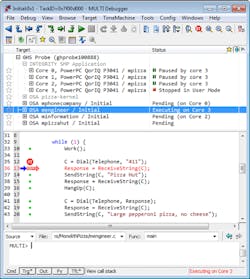Green Hills Software’s MULTI has flourished as an integrated development environment (IDE) in the embedded space along with the likes of Microsoft’s Visual Studio (see “Windows 10 and Visual Studio 2015: A Great Combination”) and the plethora of IDEs based on the open-source Eclipse project.
MULTI 7 arrives as the latest in a long line of IDEs from Green Hills (Fig. 1). The multilingual environment handles C, C++, and EC++, as well as Ada. It’s integrated with Green Hills Integrity and µ-velOSity RTOSs, plus major operating systems like Linux, Windows, VxWorks, ThreadX, and OSE. The C/C++ compiler supports clean coding conventions such as MISRA 2004 in addition to the GHS Standard Mode.
The company’s DoubleCheck static-analysis tool works with MULTI. It runs faster than typical static-analysis tools, thus reducing development-cycle time. MULTI’s run-time error checking complements DoubleCheck.
Thanks to seamless multicore debugging support, developers familiar with single-core debugging can move into a multicore environment. The Target List display highlights system components hierarchically, which helps simplify debugging and makes it easier to see relationships among applications, address spaces, tasks, and threads. The MULTI OSA Explorer provides information about the kernel objects, tasks, and resources. Also, the EventAnalyzer tracks system events and when they occur.
MULTI supports Green Hills tools like TimeMachine, a hardware trace tool that allows developers to run an application backward in time. Its PathAnalyzer highlights the call stack operation over time (Fig. 2). TimeMachine can even debug virtual-memory applications.
MULTI 7, which runs on Windows, Linux, and Solaris, supports a wide range of 32- and 64-bit chip families. Overall, MULTI meets functional safety standards, including IEC 61508:2010 (Industrial), EN 50128:2011 (Railway) and ISO 26262:2011 (Automotive). It also satisfies SIL 4 (Safety Integrity Level) and ASIL D (Automotive Safety Integrity Level), and is certified by TÜV NORD and exida.
About the Author
William G. Wong
Senior Content Director - Electronic Design and Microwaves & RF
I am Editor of Electronic Design focusing on embedded, software, and systems. As Senior Content Director, I also manage Microwaves & RF and I work with a great team of editors to provide engineers, programmers, developers and technical managers with interesting and useful articles and videos on a regular basis. Check out our free newsletters to see the latest content.
You can send press releases for new products for possible coverage on the website. I am also interested in receiving contributed articles for publishing on our website. Use our template and send to me along with a signed release form.
Check out my blog, AltEmbedded on Electronic Design, as well as his latest articles on this site that are listed below.
You can visit my social media via these links:
- AltEmbedded on Electronic Design
- Bill Wong on Facebook
- @AltEmbedded on Twitter
- Bill Wong on LinkedIn
I earned a Bachelor of Electrical Engineering at the Georgia Institute of Technology and a Masters in Computer Science from Rutgers University. I still do a bit of programming using everything from C and C++ to Rust and Ada/SPARK. I do a bit of PHP programming for Drupal websites. I have posted a few Drupal modules.
I still get a hand on software and electronic hardware. Some of this can be found on our Kit Close-Up video series. You can also see me on many of our TechXchange Talk videos. I am interested in a range of projects from robotics to artificial intelligence.



